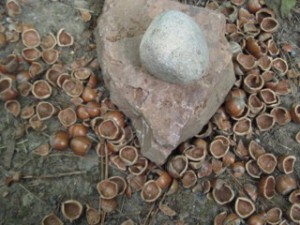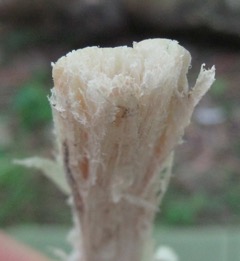As you may have understood from this blog, archaeologists do many things outside of The Excavation. One such thing happens after something has been dug. When something is discovered, it often has undefined entities. While you can often tell that something was manipulated by humans, it is rarer to immediately see what the thing in question was for. Most often, finds have to go through a period of analysis to bear meaning, and certainly to be relevant for our understanding of the entire excavation as a whole.
One type of analysis is functional analysis of lithics. Through thousands, and sometimes millions of years, stones have been worked into specific types of tools. But, even if something looks like an axe today, that doesn’t mean that it was in fact an axe thousands of years ago. We therefore carefully investigate each artefact, first to group and label them for magazines, and later to research their actual role in our society. The latter can be achieved by many means, such as residue analysis or placement on a site (for instance in a grave). However, sometimes we want to look at the practical function that a stone tool had, and we often do this through experimental means. One method that is closely linked to experimental archaeology, is use-wear analysis. Through this method, a researcher will scrutinise the tool for worn facets or edges under a microscope, and look at the patterning of the wear. Sometimes it may be criss-cross scratches, sometimes chipped edges, sometimes patches that are worn to the extent that they shine. Often, these traces are not visible to the naked eye, and we use a variety of microscopes to get the best or most detailed view of the pattern. Then, ideally the archaeologists will aim to create a replica pattern, and this is done through experimentation.
For instance, an axe will be investigated along the axe edge to determine whether it was a) used at all, b) heavily worn, and c) what the pattern looks like. After that, the archaeologist will make a replica tool and use it in one or more fashions to see if the resulting wear pattern is similar to the one on the archaeological tool.
Last year, I made a use-wear analysis of my own, on a mysterious find category from the Norwegian Mesolithic period. The tools are typically found along the coast, and often in relation to settlement sites. The artefact type consists of a hand sized beach pebble with one or two heavily worn facets, usually on either side of the stone. Not only are the stones worn, but the facets are also carefully prepared prior to use, by pecking at them with another stone. But, no one really knows what they were for, and I set out to try and come closer to this mystery.

So, I had to come up with a number of tasks that people in the Mesolithic may have done with such a tool. Then I did those tasks with replicated tools, in the hope that I would make a pattern similar to the archaeological ones. Out in the woods, I cracked 6 kg of hazelnuts, and with other stones I ground them up. Neither of the wear patterns showed any similarity to the real stones. But, with a third set of stones I bashed up some dried deer sinew, and this pattern of wear was almost identical to the archaeological stones.


In hindsight, I should probably also have rubbed some hides with the stones, as the wear trace did indicate that the stones were used on a soft, pliable surface. I will hopefully have the opportunity to go back and do that another day. But for now, a preliminary interpretation is that the stones were used with something soft that is most likely not a plant material, but not as soft as meat. It could very well be that inhabitants of the coastal settlement sites in Mesolithic Norway used these little stones to soften dried sinew before they used it to haft arrows and harpoons, or sew seal skins into bags, clothes, or tents. With more experiments, we may find out!
Tine Schenck is an experimental archaeologist with a special interest in Boreal, seasonal exploitation of resources.
